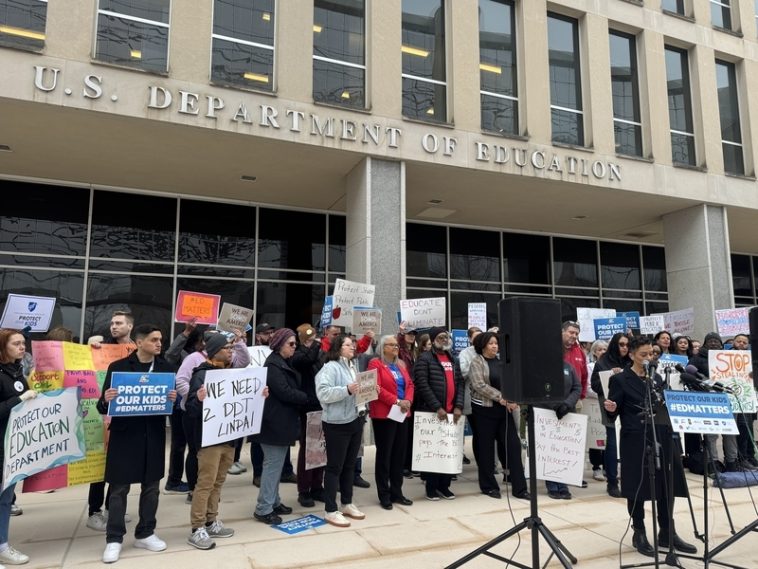
Online Education in a Digital Age: Verifying Connections and Ensuring Security
The rapid growth of online education has brought with it a host of new challenges and opportunities. In our digital era, institutions of learning—from elementary schools to universities—depend on reliable, secure online platforms. Today’s virtual classrooms are more than just tools for accessing coursework; they are complex ecosystems that must be protected against security threats, data breaches, and unauthorized access. With the increasing use of verification systems reminiscent of what many experience when browsing sites like nwlc.org, educators and policymakers alike must explore creative ways to build trust and ensure secure connection environments.
Modern technologies, including advanced verification systems managed by organizations such as Cloudflare, are designed to make your online experience safer. These systems, which include routine checks that verify whether a user is human, have become everyday encounters. A typical interaction might involve messages such as “Verifying you are human. This may take a few seconds,” followed by “Verification successful” before the website fully loads. While these checks might seem like mere technicalities, they carry significant implications for the integrity and seamless function of online education platforms.
Ensuring Secure Online Learning Environments
Online security in education is an essential concern as schools and universities integrate more digital tools into their curriculum. With students, educators, and parents relying on virtual platforms, protecting the privacy of users and the integrity of the educational process becomes a key objective. Any lapse in digital safety can disrupt learning and damage the trust built over years of academic engagement.
The process of verifying users—ensuring that each person accessing the system is real and not a piece of malicious code or an imposter—helps maintain a safe digital classroom. This process typically includes verification prompts that might at first appear to be intimidating or nerve-racking because they add an extra step before accessing content. However, these safeguards are essential for calming those uneasy about cyber threats and ensuring smooth operations throughout the digital education ecosystem.
Technology Checks as a Pillar of Trust in Virtual Classrooms
Verification systems perform several critical functions. When a student logs in to an online course platform, the system checks the connection, confirms the identity, and verifies that data transmissions are secure. This is similar to the security reviews performed by Cloudflare—leading to phrases like “Performance & security by Cloudflare” appearing on screens during the process.
Of particular importance are the following aspects:
- Protecting Personal Data: The system helps ensure that sensitive information remains confidential and is shielded from hackers.
- Preventing Unauthorized Access: By verifying that the user is human, schools can thwart attempts by automated bots or malicious actors to disrupt the educational process.
- Maintaining System Integrity: Regular security checks prevent the infiltration of malware and other potentially disruptive software.
- Building Confidence in Digital Systems: When students and teachers see that robust safety measures are in place, their overall confidence in online systems is enhanced.
These functional benefits underscore the necessity of carefully designed verification systems, despite the temporary inconvenience they might cause during login or registration processes.
State and Federal Policies Shaping Digital Education Safety
Government policies at both state and federal levels have started to reflect the pressing need for robust digital security in education. Regulatory bodies are increasingly demanding adherence to guidelines that protect the privacy of student records and ensure safe access to learning platforms. In many ways, the necessity of these policies mirrors the careful security protocols used by high-traffic websites on the internet.
For instance, state education departments are advocating for stricter cybersecurity measures and more transparent protocols for data handling. Policy makers emphasize that safe online environments are not a luxury but a must-have condition for modern education. Here are some key points where policy and practice intersect:
- Data Protection Regulations: State and federal laws require educational institutions to take proactive measures to safeguard student data from breaches and unauthorized access.
- Cybersecurity Standards: Guidelines dictate that education providers maintain secure access protocols, which include verification systems and encryption methodologies.
- Funding and Grants: Many states have recognized that bolstering digital infrastructure requires investments. Grants and funding initiatives are now common to help schools upgrade their cyber defense systems.
- Training and Awareness: State and federal agencies are funding training programs for educators to help them understand and manage tricky parts of online security.
These guidelines are loaded with issues and small distinctions that continually evolve as new technologies and threats emerge. When policymakers and school administrators work together, they can address these advances proactively rather than reactively, which ultimately benefits the overall quality of online education.
Understanding the Role of Verification Systems in Cybersecurity
The moment you see “Verifying you are human. This may take a few seconds” on a webpage, you are in for a brief interaction with a system that performs an essential service. What might appear as a minor pause in your digital journey is actually an essential checkpoint that builds a safer environment for digital engagement. Whether students are part of a virtual classroom or taking an online test, such systems provide a multi-layered defense against the constant threats that lurk in unsecured networks.
Here are some of the core functions of these verification processes:
- User Authentication: Ensuring that only legitimate users gain access. This minimizes the risk of impersonation and impersonation-related fraud.
- Data Integrity Assurance: Verifying that the data transmitted remains unaltered during its journey from the server to the user’s device.
- Mitigation of Bot Attacks: Preventing automated systems from overwhelming the server, which can otherwise lead to denial-of-service attacks.
- Enhancing User Experience: Despite the minor delays that verification might cause, the improved security translates to a smoother overall user experience because it curtails potential disruptions.
In the context of online education, these processes help create a safe harbor where academic pursuits are free from cyber disruptions. Educators can focus on teaching, and learners can focus on absorbing knowledge, with the assurance that their digital environment is secure.
Making Your Way Through the Digital Security Maze
Online security measures often present a series of tangled issues and confusing bits that can appear intimidating, especially for those less comfortable with technology. However, understanding and working through these measures is no different from mastering any new subject—it just takes a bit of time and confidence. Many institutions are now providing clear guidelines to help educators and students figure a path through these technical verifications.
Consider the following table, which outlines some common verification processes alongside their benefits and potential hurdles:
| Verification Process | Benefits | Possible Hurdles |
|---|---|---|
| CAPTCHA Challenges |
|
|
| Multi-factor Authentication (MFA) |
|
|
| IP Address Verification |
|
|
This table illustrates how different systems carry their own set of benefits and nerve-racking challenges. The ultimate goal remains clear: create a fortified environment for online learning that minimizes risks without sacrificing ease of access.
Educational Technology: Balancing Security with Accessibility
Getting into the fine points of how digital verifications operate highlights a broader debate in both educational technology and policy: how to balance robust security measures with user-friendly access. Many administrators express concern that too many layers of security can discourage users, yet too little security leaves systems vulnerable. Striking this balance is absolutely key.
Here are a few ways to ensure a robust yet intuitive digital system:
- User-Centered Design: Develop security protocols that are super important and easy for non-tech savvy users to follow.
- Layered Security: Combine multiple verification methods so that if one layer poses a confusing or nerve-racking challenge, others can reinforce the overall safety net.
- Adaptive Technology: Incorporate systems that detect irregularities and adjust the number of verification steps required on a case-by-case basis.
- Constant Feedback and Updates: Regularly gather input from educators and students to refine security processes and remove any complicated pieces that hinder day-to-day operations.
By embracing a student-first approach and ensuring that security measures are transparent and straightforward, institutions can maintain a secure online environment without placing undue burdens on users.
Building Trust in Virtual Platforms Through Transparent Security Checks
One of the small yet essential aspects of online education is building trust between students, educators, and the administration. The verification processes peppered throughout digital visits do more than protect data—they communicate a message that the institution cares deeply about the safety and well-being of every participant in the learning community.
When a user sees messages such as “Verification successful” or notices detailed security protocols in place, it reassures them that despite the twist and turns of digital interfaces, their personal information is being actively safeguarded. Here are some subtle details to consider:
- Transparency in Communication: Institutions should explain to users why these security measures are in place, emphasizing that even if these processes appear intimidating at first, they are in place for the user’s benefit.
- Accessible Support: Offering user-friendly help sections or real-time support can assist those who find the verification process off-putting or overwhelming.
- Regular Security Audits: Regular checks to ensure that the security protocols are functioning as intended help maintain the overall integrity of the digital platform.
By taking a closer look at these details, education providers can foster trust and a sense of security that benefits all parties. The goal is to make the technology less of a barrier and more of a reliable partner in the learning journey.
Community and Policy Collaboration: Securing the Future of Virtual Education
Securing online education is not solely about implementing advanced technology; it also involves policy, training, and community engagement. A multi-faceted approach can help steer through the confusing bits that arise when different institutions adopt various security protocols. Here are some critical collaborative strategies:
- Stakeholder Involvement: Engaging parents, educators, and policymakers to understand their perspectives can help create solutions that are balanced and practical.
- Industry Standards: Encouraging educational technology providers to share insights and establish common protocols fosters a safer and more unified approach to digital education.
- Regular Reviews: Continuous monitoring and assessment of security measures, in line with both state and federal guidelines, ensure that systems evolve according to new challenges.
- Professional Development: Offering workshops and training sessions aids educators in getting into the subtle parts of handling and troubleshooting security systems.
The following table compares how different stakeholders contribute to building secure online education environments:
| Stakeholder | Contribution | Potential Challenges |
|---|---|---|
| Educators |
|
|
| IT Departments |
|
|
| Policy Makers |
|
|
| Technology Providers |
|
|
Effective collaboration across these groups is super important. The combined insight from hands-on experience in the classroom and top-level policy guarantees that security checks not only protect the system but also enhance the learning experience, rather than detract from it.
Adapting to Modern Cyber Threats in Education
Online education platforms today face challenges that are as multifaceted as the digital landscape itself. Hackers, spam bots, and phishing attempts are just a few examples of the tangled issues that modern institutions must face. Even a simple message—such as the one seen when verifying a user—is borne out of a world full of problems, designed to preempt these threats and ensure that only legitimate users can access important resources.
These verification measures can be nerve-racking for someone who is not used to them, and they can slow down the process of accessing educational content. However, it is key for institutions to understand that such delays are small sacrifices for the enhanced security they provide. The slightly off-putting extra steps in the verification process contribute immensely to overall system integrity, keeping cyber threats at bay.
Many schools and districts are now exploring systems that allow them to customize these security measures, ensuring they accommodate both tech-savvy users and those who might need a bit more guidance. Customizable verification processes allow for a dynamic approach in managing your way through the online security maze, ensuring that no educational user is left behind.
Improving User Experience: Tips for a Smoother Online Journey
In line with our discussion on digital security verification, a major component of delivering quality online education lies in enhancing the overall user experience. Although the additional verification steps may seem intimidating at first, a well-designed interface can help users figure a path around any confusing bits. Here are a few practical tips for institutions to ensure a more pleasant digital journey:
- Clear Instructions: Provide simple, accessible instructions on what each security check is for and how users can successfully complete it.
- Visual Aids and Walkthroughs: Integrate step-by-step guides or short video tutorials that help users understand the process calmly.
- Responsive Support: Establish a dedicated support channel for questions regarding digital verifications so that users can quickly resolve any issues that arise.
- Feedback Mechanisms: Regularly solicit user feedback to comb through the small distinctions of the current system, letting administrators know which parts might feel too intimidating or unnecessarily complicated.
By implementing these user-friendly practices, educational platforms can relieve the frustration that sometimes comes with verifications and turn them into an engaging part of the secure online experience.
Future Trends: The Evolution of Cybersecurity in Online Education
As the digital education landscape continues to evolve, so too will the methods used to protect it. The future points to even more integrated and adaptive security systems—ones that learn from user behavior and adjust in real time to counter emerging threats. The current verification systems, while effective, might soon be replaced or augmented by more seamless solutions that minimize the need for visible checks while still providing layers of security behind the scenes.
Looking ahead, several trends seem poised to shape the future of cybersecurity in virtual classrooms:
- Biometric Authentication: Integrating fingerprints or facial recognition to provide a frictionless yet highly secure verification process.
- Artificial Intelligence and Machine Learning: Using AI to detect unusual activities and provide adaptive security responses without interrupting the user experience.
- Zero-Trust Models: Creating environments where every access request is treated as potentially harmful until it is verified, thus increasing the overall security posture.
- Blockchain Technology: Employing decentralized verification systems that are inherently secure and tamper-proof, providing a new layer of trust in the digital identity of users.
As these technologies mature, educational institutions and policymakers will have to work closely together, ensuring that the changes help streamline the user experience without sacrificing the essential protections needed in today’s cyber threat landscape.
Integrating Seamless Verification into Everyday Learning
Beyond simply protecting data, how verification systems are implemented can set the tone for the trust and security perceptions that students and educators have about a platform. When users encounter a well-thought-out system—one that provides clear messages like “Verification successful” without toxic delays—they are more likely to feel secure in using the platform. A secure system can be thought of as the backbone for a reliable virtual classroom, one that fosters a productive educational environment.
In many ways, just as teachers adjust lesson plans to ensure concepts are accessible and digestible, developers must work through the little details of security systems to ensure that they integrate seamlessly into everyday routines. Efforts are underway, both at local and federal levels, to support research and development into streamlined security protocols for virtual education.
In this regard, the education community is watching technological innovations closely, keen to see how emerging verification measures can be tailored to support a wide range of users, from digital natives to those who are just beginning to embrace virtual learning fully.
Conclusion: The Road Ahead for Digital Education Security
The world of online education is experiencing a revolution that is both promising and full of problems. As technology continues to advance at a rapid clip, the verification processes—those seemingly off-putting extra steps like “Verifying you are human…”—serve as reminders that security is an ongoing, evolving journey. These checks, though they may seem intimidating and temporary disruptions at first, are part of a larger strategy to protect personal data, maintain system integrity, and foster a secure environment for learning.
The collaborative efforts between technology providers, educators, IT professionals, and policymakers have shown that it is possible to build a secure digital ecosystem that supports the educational journey. With effective communication, adaptable verification techniques, and a commitment to user-centered design, the future of online education looks both safe and promising.
Ultimately, the small delays and intimidating checks are a small price to pay for the assurance that the digital classroom remains a safe space—a place where education can flourish without interference from malicious threats. As we work through the tricky parts and adapt to emerging technologies, our collective goal remains to ensure that every student, educator, and administrator can confidently use online platforms without fear of harmful intrusions.
By taking a closer look at the strategies discussed—from leveraging advanced security measures to aligning state and federal policies—the education community can continue to innovate and improve the overall digital learning experience. It’s not just about verifying a connection; it’s about verifying the trust that forms the foundation of education in a digital world.
In this ever-evolving digital landscape, the message remains clear: while the twists and turns of online security might sometimes seem overwhelming, every measure taken is an investment in the future of education, ensuring that learning remains uninterrupted, reliable, and secure.
Originally Post From https://nwlc.org/press-release/nwlc-condemns-education-departments-targeted-exclusion-of-non-profits-from-public-student-loan-forgiveness-program/
Read more about this topic at
Human Verification: Works Invisibly — No Captchas, or ID, …
Human verification — checking you’re a human when you …


